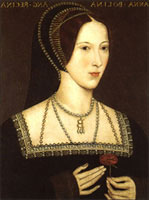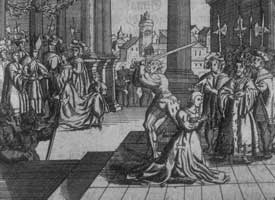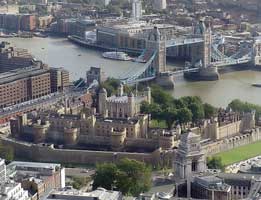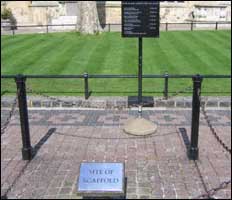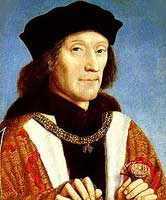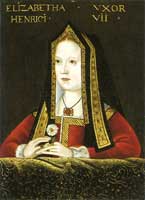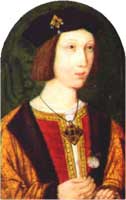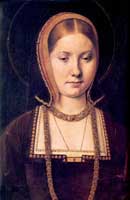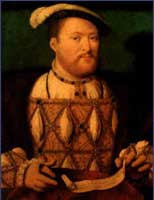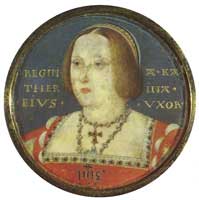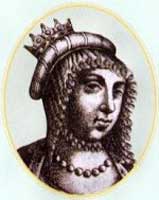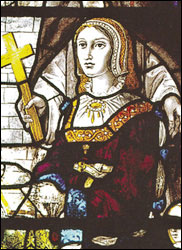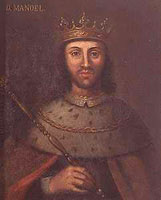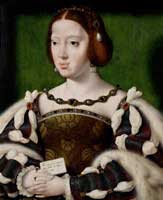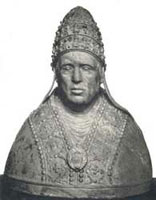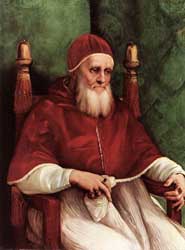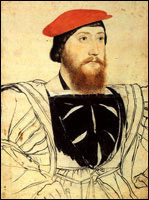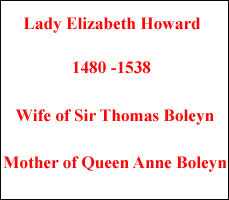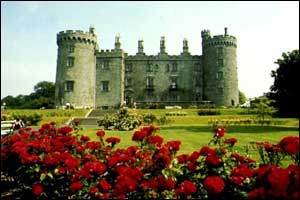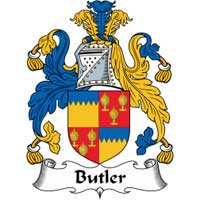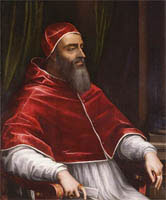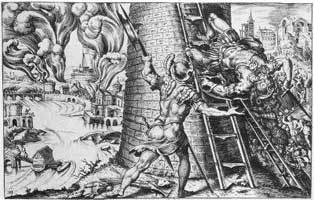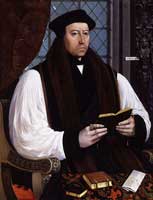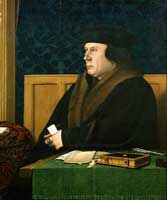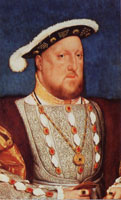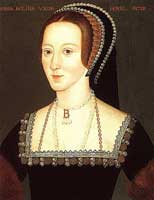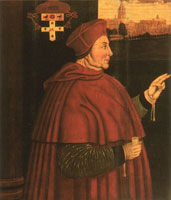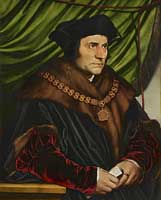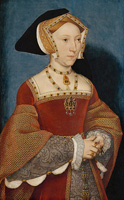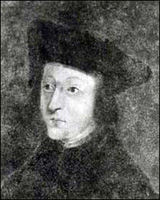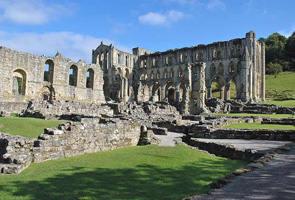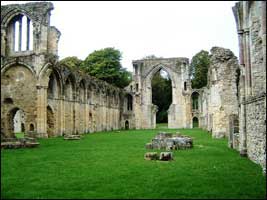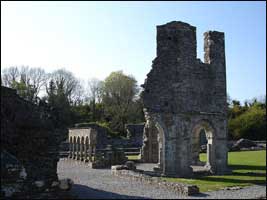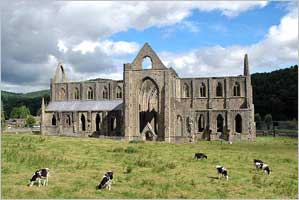| |
Saint
Anne Boleyn—A Queen in Heaven!! |
|
|
JOSHUA the
only begotten Son of God said:
Fear
none of those things which thou shalt suffer: behold, the devil
shall cast some of you into prison, that ye may be tried; and
ye shall have tribulation ten days: be
thou faithful unto death, and I will give thee a crown of life.
(Revelation 2:10).
Saint Anne
Boleyn received her crown of life 1400 years later and she
has been reigning with Christ ever since:
And
I saw thrones, and they sat upon them, and judgment was given unto
them: and I saw the souls of them that were beheaded
for the witness of Joshua, and for the word of God, and which
had not worshipped the beast, neither his image, neither had received
his mark upon their foreheads, or in their hands; and they lived
and reigned with Christ a thousand years.
(Revelation 20:4).
Thanks
to King Henry, Queen Anne Boleyn went from being the queen of England
to a queen in Heaven.
| |
Saint
Anne Boleyn (1501-1536).
Queen
from 1533-1536. |
|
| |
Queen
Anne Boleyn was BEHEADED in the Tower of London on May
19, 1536.
She
was the victim of a international conspiracy to keep England
under Papal rule at any cost.
The
royal physician made sure that she did not have
a male heir . . . and this led to her downfall! |
|
|
| |
| Beheading
of
Queen Anne Boleyn. |
|
|
Queen
Anne Boleyn was beheaded with a SWORD.... Usually the crude English
method of beheading was hacking off the head with an axe.
| |
| |
Saint
Anne Boleyn was carried to Heaven by the angels from this
exact spot.
The
queen's only "crime" was breaking up an incestuous
relationship between King Henry VIII and Catherine of
Aragon! |
|
|
| |
Tower
Hill were the queen was beheaded. |
|
|
Make
this martyr's site your #1 destination when you visit London this
year. Captain John Smith is buried here
and a replica of the Golden Hind can be found here.
Henry
and Elizabeth were the founders of the Tudor dynasty
King
Henry won the throne after the Battle of Bosworth Field in which he
defeated his rival, King Richard III. The Tudors were Welch and of
Celtic origin. The Welch were the original Britons, and King Henry
named his firstborn son Arthur, after the legendary King Arthur of
Camelot.
| |
King
Henry VII (1457-1509).
King from 1485 to 1509). |
|
| |
Henry
Tudor was king of England when the New World was discovered
by John Cabot.
The
Tudors were parents of 2 boys: Arthur and Henry, and 2
girls: Margaret and Mary.
When
Arthur was 14 years old, he was wedded to Catherine of
Aragon. |
|
|
| |
Elizabeth
of York (1466-1503).
Queen consort from 1486 to 1503. |
|
|
After
a very stormy voyage, Catherine of Aragon arrived in England on October
2, 1501. She was the daughter of Ferdinand and Isabella of Spain.
| |
Prince
Arthur (1486-1502). |
|
| |
Prince
Arthur was married to Princess Catherine of Aragon on
November 14, 1501.
The
young prince died on April 2, 1501, barely married for
5 months.
At
that time, the young widow should have packed her bags
and gone home to Spain!
|
|
|
| |
Princess
Catherine
(1485-1536). |
|
|
Control
of the New World was at stake so events took a completely different
turn.
Instead
of Catherine returning home, a vast conspiracy was set afoot to marry
her to her brother in law, Henry.
After
the death of his beloved wife Elizabeth in 1503, King Henry was searching
for a new wife. This is what an Italian historian wrote about the
king in 1506:
His
body was slender but well built and strong;
his height above the average. His appearance was remarkably attractive
and his face was cheerful, especially when speaking; his eyes were
small and blue, his teeth few, poor and blackish; his hair was thin
and white; his complexion sallow. His spirit was distinguished, wise
and prudent; his mind was brave and resolute and never, even at moments
of the greatest danger, deserted him. (Vergil, Anglica
Historia, p. 145).
King
Henry kept a tight rein on his rambunctious son. He knew that Henry
had no kingly qualities. Never was a father and son more different
in personality. He was not allowed to see Catherine. The ONLY people
with access to Catherine and Henry were the Franciscan monks. Only
the DEATH of the king would place Catherine on the throne and that
is exactly what happened.
A
RASPUTIN like Franciscan monk appeared named Fray Diego Fernandez
who helped to arrange the timely demise of King Henry.
The
king died suddenly and unexpectedly as his son turned 18. This was
the age of majority for the royal succession. The timing of the death
of his father was impeccable!!
The
new King Henry married his sister in law, Catherine of Aragon in June,
1509.
King Henry committed
INCEST by marrying his sister in law!!
The
couple were joined in UNHOLY matrimony on June 11, 1509. Henry was
18 and Catherine was 24.
| |
King
Henry VIII (1491-1547).
King from 1509 to 1547. |
|
| |
According
to the Bible, their marriage was incestuous because close
relatives are not allowed to marry.
At
that time, Henry cared little for the Bible as all he
wanted was the throne at any cost.
A
forged dispensation from Pope Julius II was produced to
legitimize their incest. |
|
|
| |
Catherine
of Aragon (1485-1536).
Queen from 1509 to 1533. |
|
|
Here
are the 2 Scriptures that forbids marriage between close relatives:
Thou
shalt not uncover the nakedness of thy brother's wife: it is thy
brother's nakedness. (Leviticus
18:16).
And
if a man shall take his brother's wife, it is an unclean thing:
he hath uncovered his brother's nakedness; they shall be childless.
(Leviticus
20:21).
John
the Baptist—the forerunner of Jesus the Messiah—rebuked
King Herod for breaking this law . . . and that led to his
beheading!!
For
John had said unto Herod, It is not lawful for thee to have thy
brother's wife.
(Mark 6:18).
A
mysterious Papal dispensation turned up in Spain supposedly from Pope
Julius II. This was a sheer fabrication by King Ferdinand and as big
a myth as Columbus discovering the New World.
Pope
Julius II never granted Henry a dispensation to commit incest!!
The
only Pope in history who ever granted a dispensation to commit incest
was the infamous Pope Alexander VI.
| |
Elizabeth
of Portugal (1470-1498).
1st wife of Manuel of Portugal. |
|
| |
These
2 sisters were married to the same man!
Pope
Alexander VI granted Manuel I of Portugal a dispensation
to marry Maria of Aragon, the sister of Elizabeth.
He
was the only Pope to ever defy the law of God in such
a blatant manner. |
|
|
| |
Maria
of Aragon (1482-1517).
2nd wife of Manuel of Portugal. |
|
|
Manuel
of Portugal's first wife Elizabeth died in 1498 and then he married
her sister, Maria. These 2 sisters were children of Ferdinand and
Isabella of Spain!
| |
King
Manuel I of Portugal (1469 -1521).
King from 1495 to 1521. |
|
| |
Pope
Alexander VI hoped that these marriages would keep the
Portuguese away from the New World.
Manuel
of Portugal's second wife died in 1517 and then he married
a Habsburg, Eleanor of Austria. |
|
|
| |
Eleanor
of Austria (1498-1558).
3rd wife of Manuel of Portugal. |
|
|
The
king's incestuous marriage was strictly forbidden by Scripture but
this king had absolutely no fear of God and the Last Day.
Cardinal
Giuliano della Rovere, the future Pope Julius II, was known as the
Warrior Pope. He was furious at Borgia because he was supposed
to be Pope in 1492—but Borgia stole the election.... It was
the most blatant example of simony in the entire history of the Papacy.
| |
Pope
Alexander VI (1431-1503).
Pope from 1492 to 1503. |
|
| |
The
infamous Rodrigo Borgia was the only Pope in history to
condone incest.
Borgia
had sex with his own daughter, Lucretia.
Pope
Julius II HATED Borgia and the Spanish faction with a
passion.
Pope
Julius was called the Warrior Pope and his whole Papacy
was devoted to driving them out of Italy. |
|
|
| |
Pope
Julius II (1453-1513).
Pope from 1503 to 1513). |
|
|
A
bitter rivalry grew up between Cardinal della Rovere and Rodrigo
Borgia:
Cardinal
Giuliano della Rovere had been the most bitter enemy of Pope Alexander
for many years.
(Puzo,
The Family, p. 214).
He
HATED the Spanish faction at Rome and after the horrible death by
poisoning of Pope Alexander VI, he determined to rid Rome of them
forever:
The
night of Alexander's death, armed mobs surged through the streets
of Rome, beating and killing anyone of Spanish descent—Catalans,
as they were called—and looting all their homes.
(Puzo,
The Family, p. 345).
The
Bull of Dispensation allowing the incestuous marriage was actually
made during the reign of Pope Alexander VI. The Pope's timely demise
probably delayed its arrival in Spain:
It
was a document which had been much pondered and on which much hung.
Yet it contained an extraordinary error of dating.
Following the normal practice of the Papal chancery, it was dated
in two ways: by the year of grace and by the year of the pontiff's
reign. But the two contradicted each other: the year of grace dating
was 'the 7th of the calends of January of the year of our Lord's Incarnation
1503' that is, in the Roman calendar, 26 December 1502; whereas 'the
first year of our pontificate' of the recently elected Pope Julius
II only began on 1 November 1503. It was the sort of error which had
invalidated many a lesser document. (Starkey, Six Wives,
p. 86).
King
Ferdinand was the last person in the entire world to receive any dispensation
from Pope Julius II.
Queen
Esther and Queen Anne
St.
Paul said that ALL the events that happened in the Old Testament were
written in order to instruct the Christians who lived during the last
days:
Now
all these things (in the Old Covenant) happened unto them for examples:
and they are written for our admonition, upon whom the ends of the
world are come. (I
Corinthians 10:11).
The
one story in the Old Testament that mirrors the story of Queen Anne
Boleyn is found in the Book of Esther. According to that history, the
Persian emperor Ahasuerus (Xerxes) had a quarrel with his wife, Queen
Vashti.
The
Persian Emperor decided to divorce his queen and look for another wife.
To find a new wife, he had a beauty contest throughout the entire Persian
empire and the most beautiful maiden was chosen as his wife. Her name
was Esther and she was a real Jew:
And
the king loved Esther above all the women, and she obtained grace
and favour in his sight more than all the virgins; so that he set
the royal crown upon her head, and made her queen instead of Vashti.
(Esther 2:17).
After
becoming the wife of the king, Queen Esther was used by JEHOVAH to spoil
a plot by the devil to kill all the Jews in the Persian empire.
It
was a most perilous time for the real Jews who were threatened with
extinction by a man named Haman. Queen Esther was advised by Mordecai
to boldly go before the king and plead for the life of her people:
For
if you remain completely silent at this time, relief and deliverance
will arise for the Jews from another place, but you and your father’s
house will perish. Yet who knows whether you
have come to the kingdom for such a time as this? (Esther
4:14).
Like her Old Testament
counterpart Queen Esther, Queen Anne risked her life to tell Henry the
good news of the Gospel of Christ. All the time she was carefully watched
by wolves like Cardinal Wolsey and Sir Thomas More.
| |
Sir
Thomas Boleyn (1477-1539), father of Anne Boleyn. |
|
| |
Anne
Boleyn was a stunning redheaded beauty who captivated King
Henry.
She
spoke with a French accent and her brains . . . and beauty
. . . came from her Butler Irish ancestors.
Like
Queen Esther, God used her mightily to advance His kingdom.
|
|
|
| |
Elizabeth
Howard was the mother of Queen Anne. |
|
|
This was a great
example of Anglo-Irish cooperation to produce the blessed Reformation.
Anne
Boleyn had a GREAT antecedent. Her great-grandfather was James Butler,
the Irish Earl of Ormonde:
Anne's prospects
of marriage came under discussion while she was still in France.
In 1515, her great-grandfather, James Butler, Earl of Ormonde, died
without any male heir of his body to succeed him. The earldom was
claimed both by his cousin, Sir Piers Butler, and by Sir Thomas
Boleyn, his grandson. It was a contest that would drag on for fourteen
years before a solution was reached, although in 1520 Sir Thomas
saw a way of resolving the dispute. He proposed a marriage between
his daughter Anne and James Butler, the son of Sir Piers. James
was described by Cardinal Wolsey as 'right active, discreet and
wise', and Thomas was agreeable to the earldom devolving upon him
if he married Anne. Boleyn's brother-in-law,
the Earl of Surrey, agreed to lay the proposal before the King,
whose consent was necessary in such matters. Anne, of course, was
not consulted, and no one thought to question whether she would
be happy to exchange the sophistication of the French court for
a primitive (Kilkenny) castle in Ireland. (Weir, The
Six Wives of Henry VIII, p.154).
Kilkenny Castle
was the ancestral home of the Butler dynasty.
| |
Kilkenny
Caste, Co. Kilkenny, Ireland. |
|
| |
Kilkenny
Castle was the ancestral home of the Butler dynasty.
This
is the connection between
St. Patrick and the blessed Reformation. |
|
|
|
|
The earldom of Ormonde,
seat of the Butler family, was the Irish connection to the blessed Reformation.
Initially
Anne wanted nothing to do with the frivolous playboy king but Henry
pursued her relentlessly after Catherine failed to produce a male heir.
The
Sack of Rome in 1527 in order to prevent King Henry's divorce!
The
Lord shut up Catherine's womb and prevented her from having male children.
King Henry VIII grew tired of her and applied to Pope Clement VII for
a divorce. For a substantial sum in gold . . . Pope Clement was ready
to grant Henry a divorce . . . euphemistically called an annulment.
The
gold reached Rome in the spring of 1527 . . . just as the Spanish were
sacking the city.
| |
Pope
Clement VII (1478-1534).
Pope from 1523 to 1534. |
|
| |
Pope
Clement VII was ready to give the king a divorce conveniently
called an annulment.
This
was anathema to King Charles V so his troops invaded and
sacked Rome in 1527.
The
Pope became a prisoner and a puppet of the Spanish which
have controlled the Papacy ever since through their Jesuits.
|
|
|
| |
The
Sack of Rome in 1527. |
|
|
Henry
was furious when he lost his gold and never obtained his divorce from
Queen Catherine. He broke with Rome and appointed himself as head of
the Church of England.
The
King's Great Matter
From
1527 onward, the DIVORCE from Catherine was called the King's Great
Matter. And it was GREAT indeed because it led to the final separation
of England from Rome.
Henry
asked all the universities in Europe to rule on the legality of his
incestrous marriage.
If
Constantinople had not fallen, the Patriarch of New Rome could have
told him plainly that such incestrous "marriages" were strictly
forbidden by the Bible . . . and the Orthodox Church.
| |
Thomas
Cranmer (1489-1556). |
|
| |
After
his failure to get a divorce from the Pope, Henry began
to advance men who favored the Reformation.
Thomas
Cranmer was appointed Archbishop of Canterbury and Sir
Thomas Cromwell was appointed his chief minister.
Thomas
Cranmer was later burned alive by Bloody Mary and Sir
Thomas Cromwell was beheaded. |
|
|
| |
Thomas
Cromwell (1485-1540). |
|
|
Thomas
Cranmer—a graduate of Cambridge University— was thoroughly
versed in the Scriptures, and was a friend of Anne Boleyn:
But
what first made Cranmer and Henry soul mates was their shared attitude
to the divorce. The King was certain to the point of obsession that
the papal dispensation sanctioning his marriage to Catherine had been
flawed because it flew in the face of scriptural prohibition. Cranmer
sincerely believed the same. Henry was surrounded by men who would
do his bidding in the annulment proceedings, who would produce arguments
in support of the royal position and devise stratagems for political
warfare. Only Cranmer, he came to believe, really understood him,
sympathised with his predicament, and interpreted as he did the signs
of divine disapprobation. Henry VIII certainly did not lack for spiritual
advisers but in Cranmer he found a man to whom he could, in complete
confidentiality, unburden himself. This gave a unique quality to the
relationship and one which Wolsey, Brandon, More and others close
to the King never shared. (Wilson, In the Lion's Court, pp.
327-328).
Anne
Boleyn was always reluctant to marry Henry, but Thomas Cranmer pointed
out to her the vital role she could play in advancing the Reformation
if she was brave and stayed in the lion's den.
Henry
and Anne were finally married in 1533
Henry
first noticed Anne when she returned from France in 1522. It took
him 11 years to break off the incestuous relationship with Catherine
and marry the love of his life, Anne Boleyn.
| |
King
Henry VIII (1491-1547).
King from 1509 to 1547. |
|
| |
It
took Henry and Anne 11 years of waiting; a shipload of
gold, endless frustration and the double-dealing of the
Vatican before he finally had the courage to marry his
sweetheart.
The
one good outcome of the whole sordid affair was that England
and Ireland broke with Rome permanently. |
|
|
| |
Queen
Anne Boleyn (1501-1536).
Queen from 1533-1536. |
|
|
Henry
was fully confident that Anne would give him a male heir. When their
first child was a girl he was disappointed. Little did he know that
their daughter Elizabeth
would later become England's greatest queen.
The
most important person in England at that time was the royal doctor.
He had the power of life and death over the ruling dynasty. The
doctor that "treated" Anne during her pregnancies was
John Chambre (d. 1549). After the birth of Elizabeth, she had at
least 4 miscarriages:
Listed
first in the letters patent founding the College, John
Chambre or Chambers, like Linacre, combined medicine with
the priesthood. A native of Northumberland, Chambre came to Merton
College, Oxford, for the undergraduate and graduate arts courses,
and then enrolled at Padua for the M.D. He became physician to the
king upon his return to England. With Linacre as President of the
College, Chambre served as one of the College's censors, officers
responsible for inquiring about all medical practices in the kingdom
and for burning impure medicines used by unlicensed practitioners.
He held the post of canon of Windsor from 1509 until his death,
plus prebendaries in Sarum and Lincoln, and in 1524 was appointed
Archdeacon of Bedford. Later that year he succeeded Linacre as the
king's principal physician. Unlike Linacre, however, Chambre had
to wrestle with Henry VIII's decision to establish a national church
in England and split from the Roman Catholic fold; in 1536 he subscribed
to the Articles of Faith and was rewarded for his loyalty to the
king with the deanship of the collegiate chapel of St. Stephen's
in Westminster. Additional ecclesiastical perquisites by 1540 included
the post of treasurer of the cathedral of Bath and Wells, preferments
in one Irish and three English dioceses, and the headship of his
alma mater, Merton College. Dr. Chambre used his substantial fortune
to build new cloisters for the collegiate chapels.
Chambre cared for Anne Boleyn in her confinement
and delivery of the Princess Elizabeth, as well as attending the
disastrous labor of Henry's third wife, Jane Seymour. Although
the king got the son he desperately wanted, Queen Jane died in October
1537 after a reported Caesarean section led to a fatal infection.
George Owen, another Henrician physician, probably performed the
operation, along with William Butts and Chambre. Fittingly, perhaps,
in view of the virtual death sentence to which Jane was doomed,
Chambre signed himself "priest" on the letter announcing
the seriousness of her condition. (Furdell,
The Royal Doctors, p. 24).
Obviously
John Chambre made sure that the queen did not have a living male heir.
A
few of the main conspirators in the death of Queen Anne Boleyn
Cardinal
Wolsey and Sir Thomas More were the last days equivalent of the wicked
Haman who tried to kill all the Jews in the Persian empire.
The
plot to destroy the queen was an international conspiracy
involving the Pope, the unholy Roman emperor, and the queen's numerous
domestic deadly enemies.
| |
Cardinal
Wolsey (1475-1530). |
|
| |
Cardinal
Wolsey and Sir Thomas More were the main conspirators
in the death of Queen Anne.
Both
men burned Christian bodies . . . and Bibles
. . . in order to keep the Word of God out of England!
Not
only was control of England and Ireland at stake but control
of the entire New World.
|
|
|
| |
Sir
Thomas More (1478-1535). |
|
|
Jane
Seymour was used by Cardinal Wolsey and Sir Thomas More in order to
cause the downfall and death of Queen Anne. Jane Seymour was introduced
at Court in order to supplant the queen:
| |
Queen
Jane Seymour (1508-1537).
Queen from 1536 to 1537. |
|
| |
Jane
Seymour was directed to supplant Queen Anne after she
failed to produce a male heir.
The
Queen died in childbirth while under the "care"
of the king's physician, John Chambres.
Eustace
Chapays was the court liaison with unholy Roman Emperor
Charles V. |
|
|
| |
Eustace
Chapys (1490 -1556). |
|
|
Jane Seymour's
reign turned out to be very short indeed. She gave birth to a boy
who would later reign for only 6 years as Edward VI:
The imperialists
were aware of this too, and thus Jane Seymour found herself courted,
not only by Henry VIII, but also by Anne's enemies and Chapuys's
faction. The ambassador advised her to drop
heavy hints about Anne's heretical leanings in Henry's ear, and
to say that the people of England would never accept her as their
true Queen. She must say these things in the presence of her supporters,
who would all then swear, on their allegiance to the King, that
she spoke the truth. Jane certainly acted upon this advice, and
it had the desired effect upon the King, who was now receptive to
criticism of his wife. Jane also followed her own instincts,
and the advice of her friends, by not admitting Henry to her bed.
Instead, she dropped heavy hints about marriage, which fell on fertile
ground, and before long Henry began to behave towards her with great
circumspection, leading others to believe that he was already considering
her as a future wife. From this time on, he took care to avoid any
hint of scandal attaching itselto her name; her family and adherents
were quick to notice this new deference on the part of the King,
and Sir Francis Bryan told Jane's parents that they would shortly
see their daughter 'well bestowed' in marriage. (Weir, The Six
Wives of Henry VIII, p. 306).
All 3 of the plotters died soon afterwards. Wolsey died on his way
to the Tower and Sir Thomas More was beheaded in 1535. Jane Seymour
died in childbirth in 1537. Her son Edward died from poison in 1553,
and Elizabeth, the daughter of Anne Boleyn, went on to become England's
greatest queen.
The
Suppression of the Monasteries was another great result of the Reformation!
Believe
it or not, the Vatican owned 40% of the real estate in pre-Reformation
England. Vast structures called monasteries covered the land like
the plague of locusts on ancient Egypt.
The
Suppression of those houses of ill repute was another great result
of the Reformation.
Saint
Martin Luther published a book entitled De votis monasticis
(On the monastic Vows), a treatise which declared that the monastic
life had no Scriptural basis, was pointless and also actively immoral
in that it was not compatible with the true spirit of Christianity.
Queen
Anne introduced her husband to that tome and thus began the downfall
of the immoral monasteries.
| |
Ruins
of Rievaulx Abbey in Yorkshire. |
|
| |
Most of the
abbeys were pulled down and the stones were used by the
locals to build their own houses.
The copper on the roofs
was turned into bronze cannon for the king's ships.
Why
are the ruins still standing?
Maybe
the Vatican wants to reclaim them someday! |
|
|
| |
Ruins
of Netley Abbey in Hampshire. |
|
|
The
commissioners sent by the king to survey the spiritual state of the
monasteries found the most gross immoralities.
The
king used the vast confiscated gold and silver of the monasteries
to help the poor, fortify the country against invasion, and build
up the English navy.
| |
Ruins
of Mellifont Abbey in Ireland. |
|
| |
Mellifont
Abbey was a Cistercian monastery built by the first Irish
monk, Malachy O' Morgain.
Malachy
predicted that 112 Popes would reign from his day (1142)
until the end of time!!
A
Latin Church monk was never seen in Ireland
before the 12th century!!
|
|
|
| |
Ruins
of Tintern Abbey in Wales. |
|
|
Here
is a contemporary report on the utter corruption of the convents and
monasteries:
|
The
King had matters other than romance on his mind. He was now
desperately in need of funds. Cromwell had pointed out to him
that the income of the government was only two-thirds that of
the Church, which was England's greatest landowner, with enormous
wealth in the form of land, houses and money. Cromwell's report,
Valor Ecclesiasticus, initiated an inquiry into the
abuses of monasteries and convents. Commissioners paid lightning
visits around the country, making shocking discoveries.
Their
report was presented to Parliament on 4 February. All but the
prologue of the Report of the Commission, known as the 'Black
Book', was destroyed under the reign of Bloody Mary. Enough
survives to give a taste of the alarming revelations that triggered
a wave of disgust and outrage against the Church. Far from observing
vows of poverty, chastity, and obedience,
There
were found in them not seven, but more than 700,000 deadly
sins.
Alack! my heart maketh all my members to tremble when
I remember the abominations that were there wed out.
O Lord God! ... the iniquities of those religious ...
the monstrous lives of monks, friars, and nuns have destroyed
their monasteries and churches, and not we. |
Moral
corruption, venal habits and debauchery were commonplace. Absentee
careerists lived off the revenues of sees and parishes they
had never even seen.
Monks
and nuns confessed to immoral acts, including incest, homosexuality
and child abuse. At Langdon Abbey near Dover, Abbot Dyck was
discovered in flagrante delicto. The monks at Waltham
Abbey who visited the convent at Chesham by passing along a
narrow path were ambushed by the commissioners. Pregnant nuns
were found in various places and at Cartmel one sister had six
children. The Abbot of Fountains Abbey kept six women while
a prior had seven children. (Denny, Anne Boleyn, pp.
248-249). |
Unfortunately,
the Black Book of monastic crimes was burned during the reign of Bloody
Mary Tudor.
Lady
Wingfield and the death of Queen Anne Boleyn
Incredible
as it may seem, Queen Anne had a lady in waiting named Lady Wingfield.
Lady Wingfield was the wife of Sir Richard Wingfield, grandfather
of Edward Maria Wingfield of Jamestown
infamy:
Although we
do not know what it was, one of the most damning pieces of evidence
against Anne came from someone who claimed to have spoken to
Bridget Wiltshire, Lady Wingfield, before that lady's death
in 1533. The daughter and heiress of Sir John Wiltshire of Stone
Castle, Kent, Bridget had married the courtier, diplomat and substantial
Huntingdonshire landowner, Sir Richard Wingfield of Kimbolton Castle,
around 1513, and borne him ten children before his death in 1525.
Thereafter she was married twice more, to Sir Nicholas Harvey of
Ickworth, who died in 1532, and by whom she had four sons, and to
Sir Robert Tyrwhitt of Kettleby, who long outlived her. She had
last received a New Year's gift from the King in January 1533 and
probably died later that year.
Lady Wingfield's hearsay testimony was mentioned by Sir John Spelman,
a justice of the King's Bench and a member of the jury that would
try the Queen and her alleged lovers. He recorded in his Commonplace
Book: "Note that this matter was disclosed
by a woman called the Lady Wingfield, who had been a servant to
the Queen and shared the same tendencies; and suddenly the said
Wingfield became ill, and a little time before her death she showed
the matter to one of those etc." Whatever Lady Wingfield
had confided, if she in fact said anything at all, could only have
related to the period prior to her death in 1533-34, and whoever
repeated her words had kept these revelations to him—or herself
for at least two years. That is perhaps understandable, for during
that period the law had come down heavily on anyone who spoke ill
of the Queen. But once word got out that her conduct was the basis
for an investigation, that person—who might have been Thomas
Harvey, Lady Worcester, Nan Cobham, or the "one maid more"
referred to by Husee—may have felt obliged to speak out. (Weir,
The Lady in the Tower: The Fall of Anne Boleyn, p. 79-80).
Editor's
Note
10
is the symbolic number in the Bible for completeness or totality.
1,000 (10x10X10) is also used for a complete number. JEHOVAH owns
the cattle on a thousand hills meaning
He owns ALL the cattle:
For
every beast of the forest is mine, and the cattle upon a
thousand hills. (Psalm 50:10).
Vital
Links
References
Bond,
John. In the Pillory. The Tale of the
Borgia Pope, The Fellowship Forum Washington City, 1929.
Denny,
Joanna. Anne
Boleyn. A New Life of England's Tragic Queen. Perseus Books
Group, Cambridge, MA. 2004.
Furdell,
Elizabeth Lane. The
Royal Doctors 1485-1714. Medical Personnel at the Tudor and Stuart
Courts.
University of Rochester Press, 2001.
Puzo,
Mario, The
Family. HarperCollins Publishers, New York, 2001.
Starkey,
David. Six
Wives: The Queens of Henry VIII.
Charro & Windus, London, 2003.
Vergil,
Polydore. The Anglica Historia
of Polydore Vergil, A.D. 1485-1537 .(translated by Denys
Hay), Office of the Royal Historical Society, Camden Series, London,
1950.
Wilson,
Derek,
In the Lion's Court. Power, Ambition and Sudden Death in the Reign
of Henry VIII. St. Martin's Press, New York, 2001.
Weir,
Alison. The Six Wives of Henry VIII. Grove Press, New York,
1991.
Weir,
Alison.
The Lady in the Tower: The Fall of Anne Boleyn. Ballantine
Books, New York. 2010.
Copyright
© 2010 by Niall Kilkenny
Back
to Main Menu
|
